Prague ST Vitus Cathedral
If you’ve read the post about Legend of ST Vitus then we arrive at the year 925 and Wenceslas, Duke of Bohemia (later to be known as Good King Wenceslas) is gifted a relic (bones) of ST Vitus by Henry the First, King of Germany (if you thought that was nice of him then just to note that 4 years later Henry invaded Bohemia and forced Wenceslas to pay tribute).
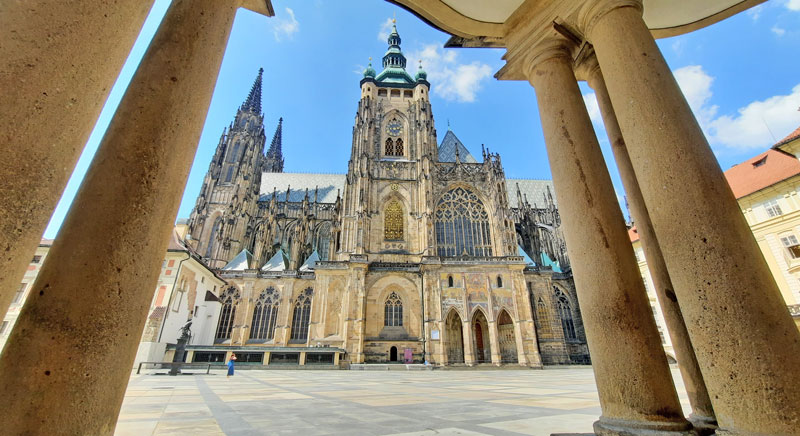
ST Vitus by now is being venerated across Europe from France to the Balkans and is already patron saint of protection against Epilepsy, Storms and Animal Attacks although why these last two are associated with him I don’t know. And why was Wenceslas so interested in ST Vitus, the patron saint of animal attacks? Remember that this is the 10th Century. Scarily it could just have been the name because in Czech it’s pronounced “Svaty Vit” and there just happened to be a pagan god of war called “Svantovit” at the time (check the Slav Epic Part Two). In any case, it was relics from an official saint.
The Rotunda and the Church
Prague Castle would have been about 150 years old in the year 925 when Duke Wenceslas started construction of a rotunda built in the present-day 3rd courtyard which would have been located towards the south side of the present Prague ST Vitus Cathedral. This would be the resting place for the relics of ST Vitus.
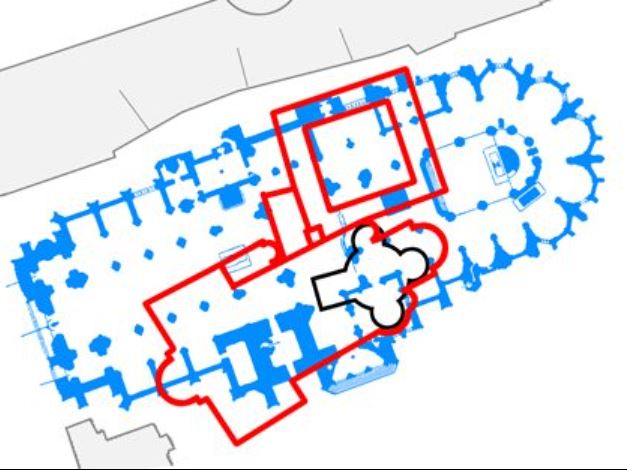

Around the year 1060 and after Wenceslas has died the site receives an upgrade when Prague becomes a Bishopric. The Rotunda was then absorbed into the church, part of which you can still see on the south side of ST Vitus Cathedral. In the first picture above you can see the original layout of where the Rotunda was sited (in black), how the Church then absorbed the Rotunda (in red) and finally how the Cathedral absorbed everything (in blue). The second picture above shows both the Rotunda and Church plus the height of the church in relation to the present-day Prague ST Vitus Cathedral. As you can see it’s not too different to what we have now, just smaller and with no high tower on the south side.
The Prague ST Vitus Cathedral
In the year 1344 it was all change again when Prague was recognised as an Archbishopric and becomes represented by a Cardinal in the Vatican. The great celebration of this was the plan to build what you see today covering almost 7500 square metres and build it as a task of 4 generations (120 years) although it took a little longer than expected, about 400 years longer.
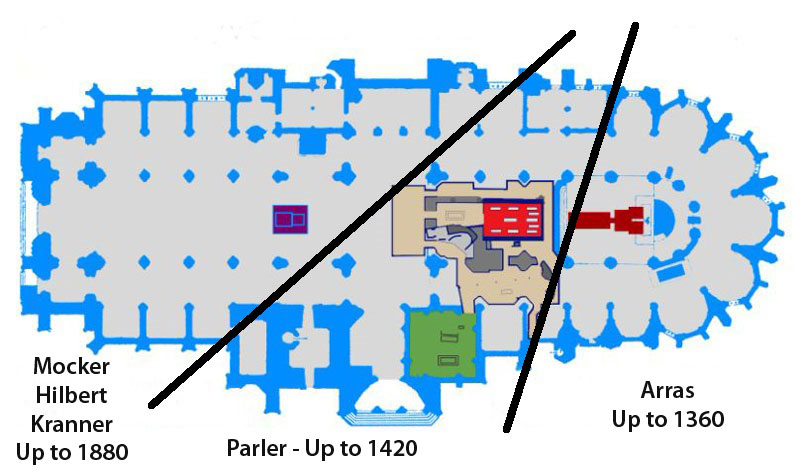
In the picture above I’ve divided ST Vitus Cathedral roughly into it’s three stages. The oldest is at the rear, started by Matthias of Arras in 1344 but he could only build the rear nave, old sacristy and chapels before he died in 1360. Then Petr Parler and his sons take over finishing the nave to the east, the most important chapels and the High Tower taking it up to 1420 when the Hussite War begins. Then it’s pretty much all stop until the Cathedral is damaged by the 1541 great fire and again rebuilt. They layout of the eastern nave was changed to allow for the tomb of Jan Nepomuk as he was canonized in 1727. Prague ST Vitus Cathedral was then damaged again during a war with the Prussians in 1757. Then the fund for the restoration and completion of ST Vitus Cathedral launches in 1840 and the money is raised to complete the original plans for the Transept, the rest of the nave and the west entry. At that point the architects Josef Mocker, Kamil Hilbert and Josef Kranner completed the job (Fun Fact: Matthias of Arras and Petr Parler are both buried in ST Vitus Cathedral).
Entering Prague ST Vitus Cathedral
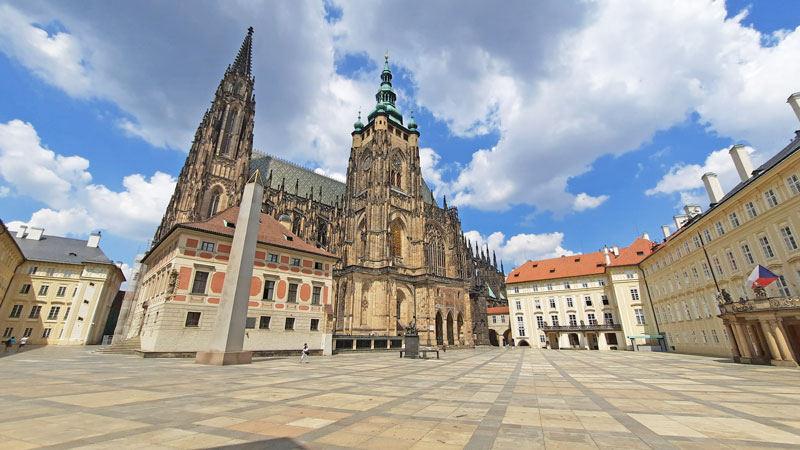
To properly explore ST Vitus Cathedral you will need to buy either the Circuit A or Circuit B Historic Building ticket and take my word for it, if you want your monies worth from the Cathedral it’s worth renting the Audioguide for a few hours. But that doesn’t stop you from going inside. Although they will limit the number of people in ST Vitus Cathedral when you get inside you’ll find you are in a kind of reception area with a terrific view of the nave and leaded-light windows at the western end.
Tour Tips: You can access St Vitus Cathedral for FREE but if you want to explore it you need the historic buildings ticket. the four tours below allow you to skip the ticket queue. Two are for self-guiders and the other two are for people who want to join a guided tour.
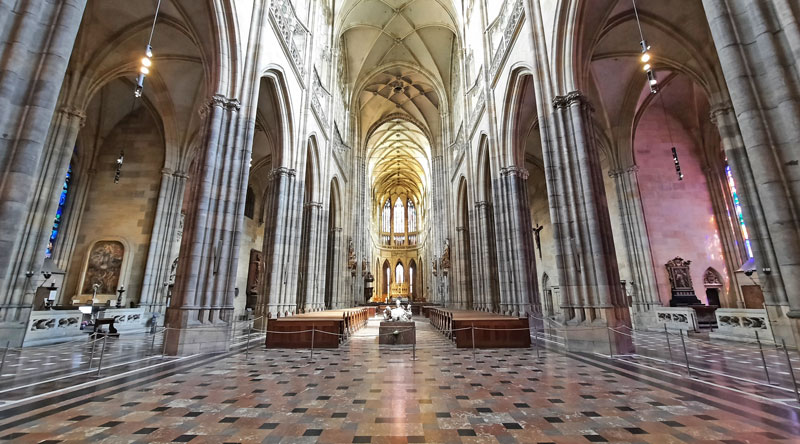
Look at the Prague Castle Tours post to see what’s accessible on the various tickets. You do NOT need a ticket to access the cathedral but you will need one if you want to explore. On your left you’ll find automatic gates with QR code readers. Present your ticket and in you go so you will explore Prague ST Vitus Cathedral in a clockwise direction. My favourite first stop is the “Slavia Bank” leaded-light window 3rd from the end by Alfons Mucha installed in 1929. This followed the previous year when he (and his sponsor) had presented the Slav Epic to the Czech people but the graphics in this window are more religious (pictured later in this post).
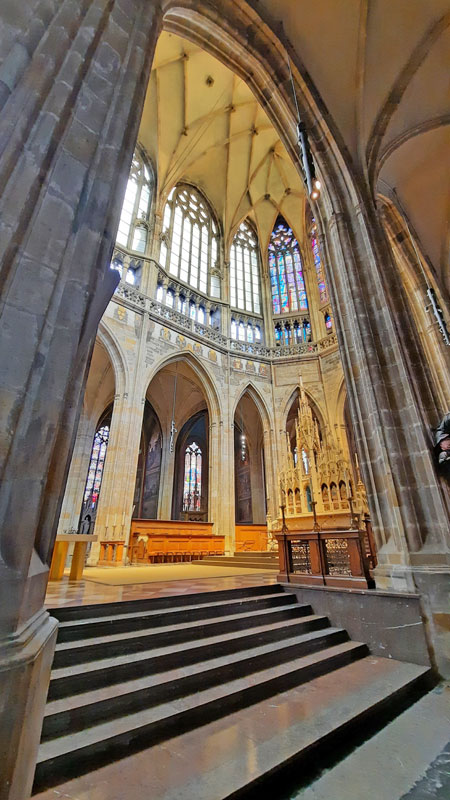
There are various chapels to the left and when you reach the centre of the church the organ will be up on your left but you might not even see it because your eyes will be drawn up between the Gothic supports into the heart of the nave (it’s 33.2 metres tall) especially if the sun is shining.
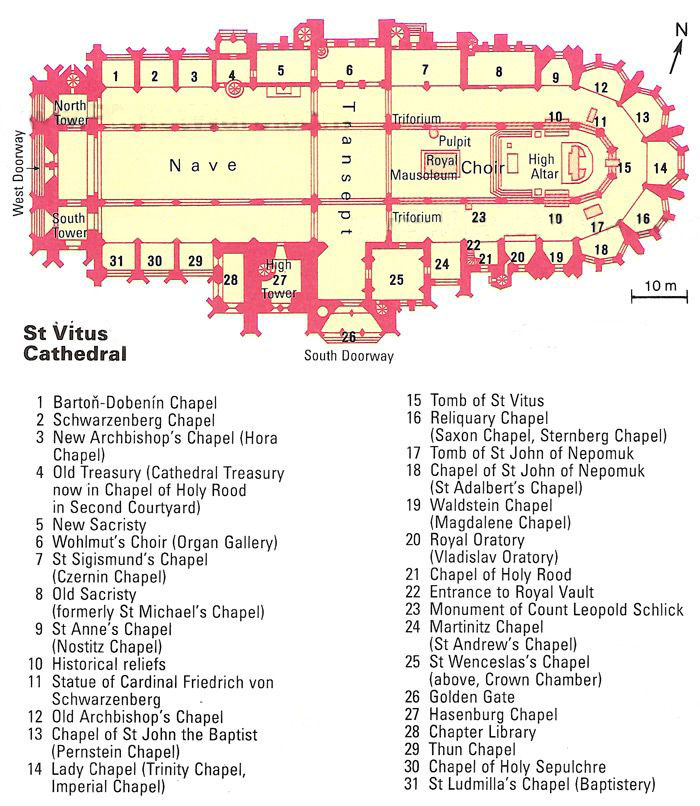
The picture above shows the layout of Prague ST Vitus Cathedral today including the names of the chapels. What I like about this particular graphic is that it associates the name of the chapel with the family that would have used it i.e. ST Annes Chapel was used by the Nostic family, Magdalene Chapel was for the Waldstein family, the Saxon Chapel for the Sternbergs etc.
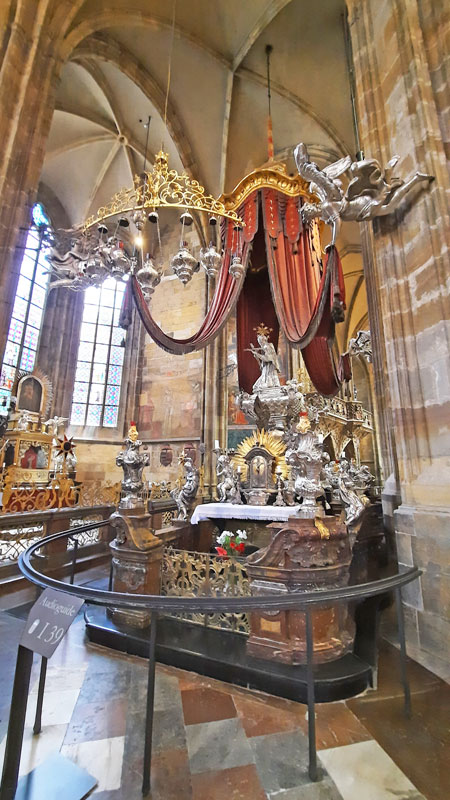
There’s a sacristy after the organ then the chapels start again at the far end and proceed around to the right. The “Tomb” of ST Vitus is right at the end of the nave opposite the Trinity/Imperial chapel but remember, he’s not buried here. Then it will get very narrow because of the extra ornamentation in the far right corner for the adoration of Jan Nepomuk (pictured above). It looks like an afterthought which it was because it got added in 1727 and further embellished over the next 50 years but remember this end of the ST Vitus Cathedral was designed for senior royals so for him to be here is a sign of his importance even as a non-royal.
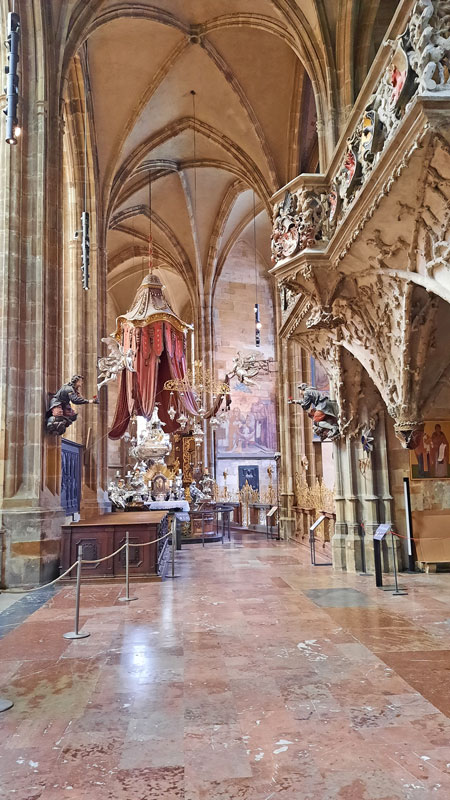
After you have passed Jan Nepomuk your eye will naturally be drawn to the far end of the cathedral. If you now look up to your left you’ll see the overhanging Royal Oratory which was built especially for the royal family to be able to pray in peace and quiet over the royal tomb.
ST Wenceslas Chapel
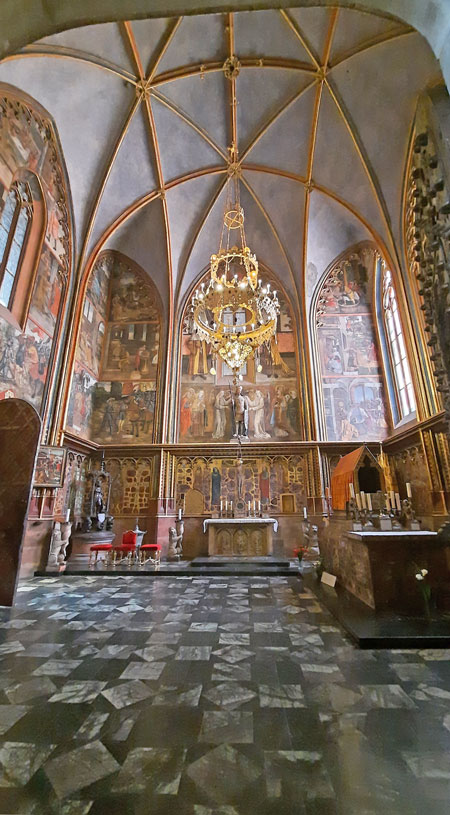
After the Oratory you arrive at the Transept of Prague ST Vitus Cathedral then the ST Wenceslas Chapel is on your left adjacent to glass doors which would have led to the south side entry. A few special things here include the actual relics of Wenceslas, Duke of Bohemia who was elevated to King posthumously and then became the Czech Patron Saint. In the floor plan pictured earlier you’ll see that the ST Wenceslas Chapel is sited directly on the land which held his original Rotunda to ST Vitus. Finally, this room is opened to the public on average every 8 years if there is an exhibition of the Czech Crown Jewels of which one just happens to be the hand of ST Vitus.
On the Way Out
As you leave ST Wenceslas Chapel be sure to walk to the centre of the ST Vitus Cathedral to be able to get some stunning pictures. Look to the east for the Royal Tomb, the choir and the short part of the nave. Look to the west for the larger part of the nave and the Rose Window above the west entry. Finally more chapels on the left with very colourful leaded-light in the sun.
If there’s anything you want to go back and see then do it now because once you cross the ropes you have exited the ticketed area and you will need to pay again if you want to go back later (your ticket is only good for one entry).
Recent Changes
Prague ST Vitus Cathedral was officially consecrated in 1929 in it’s completed form. The date chosen for the consecration was the 1000th anniversary of the death of ST Wenceslas. In 1931 the New Archbishops Chapel had the window created by Alfons Mucha and paid for by the Slavia Bank (Banka Slavie) installed showing scenes from the lives of ST Cyril and ST Methodius.
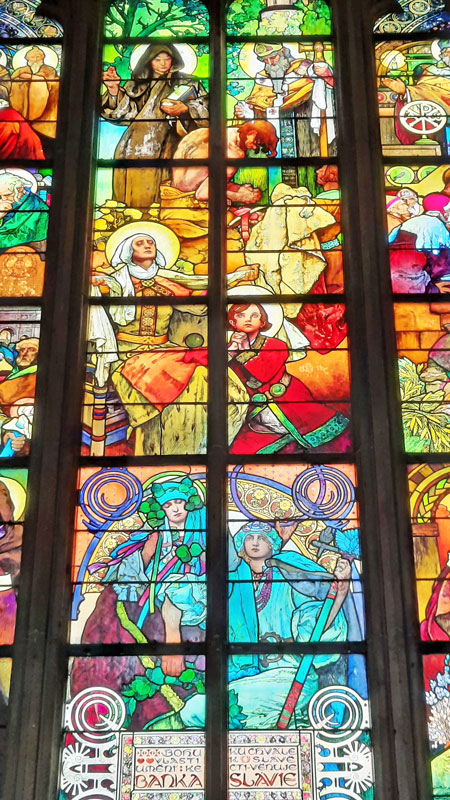
In recognition of the relics in the Prague ST Vitus Cathedral, in 1997 it was renamed officially to the Cathedral of St Vitus, ST Adalbert and ST Wenceslas, although everybody still refers to it as ST Vitus.
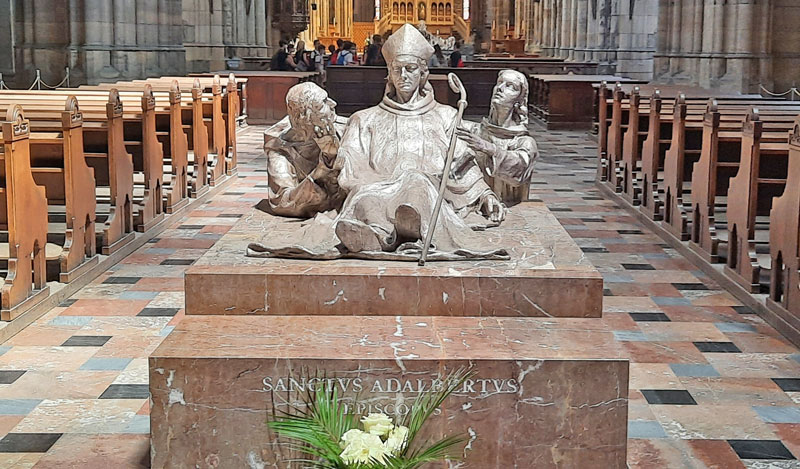
In what I call the free-to-enter area if you look straight ahead there is a silver figure. This is ST Adalbert (Czechs call him SV Vojtech) who was second Bishop of Prague who died a martyr having been murdered by Prussian pagans. He was always honoured in this spot first with a marble model and later with a raised floor motif. The current version is cast from 320Kg of silver and was installed in 2018.
Something Related or a Few Minutes Away
ST Vitus Cathedral Religious Services Schedule
Parks and Gardens – Imperial Gardens at Prague Castle
Food and Drink – ST Wenceslas Vineyard at Prague Castle